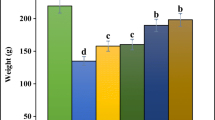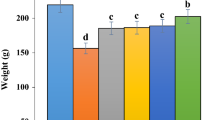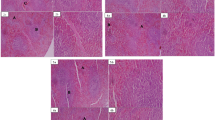Abstract
Sub-Saharan Africa with anemia prevalence of 68% could qualify as the anemia capital of the world. Anemia in this region affects mainly pregnant women and children. The high incidence of malaria in sub-Saharan Africa makes anemia incidence worse as malaria parasites cause hemolytic anemia. Available treatments seem unpalatable due to side effects. The populace seeks medical attention via their traditional therapies like herbs. This study is aimed at evaluating the use of Mucuna pruriens herb in the treatment of hemolytic anemia secondary to malaria. Thirty-six adult male rats weighing between 150 and 200 g were divided into six groups (n = 6). Group I served as the negative control and received syrup formulation without the extract (placebo) but allowed access to food and water ad libitum. Groups II to VI received phenyl hydrazine 60 mg/kg for 3 days to induce anemia. Additionally, groups IV to VI received 50 mg/kg, 100 mg/kg, and 200 mg/kg of Mucuna pruriens syrup formulation respectively, while group III received a standard drug. Feed and water consumption were measured weekly while PCV, Hb, RBC, platelet, ESR, MCV, MCHC, MCH, WBC, lymphocytes, neutrophils, monocytes, eosinophils, and basophils were measured before anemia induction and at days 0, 7, 14, and 21. Phytochemical analysis of the extract was also carried out. Administration of phenylhydrazine significantly decreased (p < 0.05) the levels of PCV, Hb, and RBC, respectively. Also, there is a significant increase in monocytes. Phytochemical analysis shows the presence of phenols, flavonoids, saponins, tannins, glycosides. Mucuna pruriens is effective in the treatment of PHZ induced hemolytic anemia.



Similar content being viewed by others
References
Accrombessi M, Ouédraogo S, Agbota GC, Gonzalez R, Massougbodji A, Menéndez C and Cot M (2015) Malaria in pregnancy is a predictor of infant haemoglobin concentrations during the first year of life in Benin, West Africa. PLoS One 10(6):e0129510
Agbor GA, Oben JE, Ngogang JY (2005) Haematinic activity of Hibiscus cannabinus. Afr J Biotech 4(8):833–837
Aikins ADG, Unwin N, Agyemang C, Allotey P, Campbell C and Arhinful D (2010) Commentary Tackling Africa's chronic disease burden: from the local to the global.
Alegana VA, Okiro EA, Snow RW (2020) Routine data for malaria morbidity estimation in Africa: challenges and prospects. BMC Med 18:1–13
Antony AC (2008) Severe anemia in Malawian children. N Engl J Med 358(21):2291
Ashour TH (2014) Phenylhydrazine-induced hemolytic anemia in rats. Res J Med Sci 8:67–72
Barcellini W and Fattizzo B (2015) Clinical applications of hemolytic markers in the differential diagnosis and management of hemolytic anemia. Disease markers 2015
Bell A, Neely C (1980) Smear platelet counts. South Med J 73(7):899–901
Chauhan SP, Sheth NR and Suhagia BN (2015) Hematinic effect of fruits of Opuntia elatior Mill. on phenylhydrazine-induced anemia in rats. Ayu 36(2):208
Chen Y-H, Feng H-L, Jeng S-S (2018) Zinc supplementation stimulates red blood cell formation in rats. Int J Mol Sci 19(9):2824
Chourasiya A, Sahu RK and Khan MA (2019) Anti-Anemic and haemopoietic evaluation of Trigonella foenum-graecum (Fenugreek) in rodent model. J Drug Del Therap 9(4-s): 332–337
Crawley J (2004) Reducing the burden of anemia in infants and young children in malaria-enAn updated review on taxonomydemic countries of Africa: from evidence to action. Am J Trop Med Hyg 71(2_suppl):25–34
Deokar G, Kakulte H, Kshirsagar S (2016) Phytochemistry and pharmacological activity of Mucuna pruriens: a review. Pharmaceutical and Biological Evaluations 3(1):50–59
Fam BC, Joannides CN, Andrikopoulos S (2012) The liver: key in regulating appetite and body weight. Adipocyte 1(4):259–264
Gheith I and El-Mahmoudy A (2018) Laboratory evidence for the hematopoietic potential of Beta vulgaris leaf and stalk extract in a phenylhydrazine model of anemia. Braz J Med Biol Res 51(11)
Goorani S, Koohi MK, Zangeneh A, Zangeneh MM, Moradi R (2019) Pharmacological evaluation of anti-anemic property of aqueous extracts of Falcaria vulgaris leaf in rats. Comp Clin Pathol 28(5):1221–1227
Harborne J (1984) Phytochemical method: a guide to modern techniques of plant analysis. Chapman and Hall Publications, London and New York
Higgins T, Beutler E, Doumas B (2008) Measurement of haemoglobin in blood. In: Burtis C, Ashwood E, Bruns D (eds) Tietz Fundamentals of Clinical Chemistry, 6th edn. Saunders Elsevier, Missouri, USA, pp 524–525
Innih SO, Omage SO, Omage K (2020) Hematinic effects of Spondias mombin and its protective role against the spleenotoxic effect of phenylhydrazine. Clinical Phytoscience 6:1–9
Jakeman G, Saul A, Hogarth W, Collins W (1999) Anaemia of acute malaria infections in non-immune patients primarily results from destruction of uninfected erythrocytes. Parasitology 119(2):127–133
Kahigwa E, Schellenberg D, Sanz S, Aponte JJ, Wigayi J, Mshinda H, Menendez C (2002) Risk factors for presentation to hospital with severe anaemia in Tanzanian children: a case–control study. Tropical Med Int Health 7(10):823–830
Kenangalem E, Karyana M, Burdarm L, Yeung S, Simpson JA, Tjitra E, Douglas NM (2016) Plasmodium vivax infection: a major determinant of severe anaemia in infancy. Malar J 15(1):1–10
Korenromp EL, Armstrong-Schellenberg JR, Williams BG, Nahlen BL, Snow RW (2004) Impact of malaria control on childhood anaemia in Africa–a quantitative review. Tropical Med Int Health 9(10):1050–1065
Kumar P, Saha S (2013) An updated review on taxonomy, phytochemistry, pharmacology and toxicology of Macuna pruriens. J Pharmacogn Phytochem 2(1)
Luangaram S, Kukongviriyapan U, Pakdeechote P, Kukongviriyapan V, Pannangpetch P (2007) Protective effects of quercetin against phenylhydrazine-induced vascular dysfunction and oxidative stress in rats. Food Chem Toxicol 45(3):448–455
Madhikarmi NL, Murthy KRS (2015) Biochemical studies on phenylhydrazine induced experimental anemic albino rats. Journal of Universal College of Medical Sciences 3(1):41–47
Magalhães RJS, Clements AC (2011) Spatial heterogeneity of haemoglobin concentration in preschool-age children in sub-Saharan Africa. Bull World Health Organ 89:459–468
Magnani M, Rossi L, Cucchiarini L, Stocchi V, Fornaini G (1988) Effect of phenylhydrazine on red blood cell metabolism. Cell Biochemistry and Function: Cellular Biochemistry and Its Modulation by Active Agents or Disease 6(3):175–182
Moraleda C, Aguilar R, Quintó L, Nhampossa T, Renom M, Nhabomba A, Achtman AH (2017) Anaemia in hospitalised preschool children from a rural area in mozambique: a case control study in search for aetiological agents. BMC Pediatr 17(1):1–10
Mulenga M, Malunga P, Bennett S, Thuma PE, Shulman C, Fielding K, Greenwood BM (2005) Factors associated with severe anaemia in Zambian children admitted with Plasmodium falciparum malarial anaemia. Ann Trop Paediatr 25(2):87–90
Muniyandi K, George E, Sathyanarayanan S, George BP, Abrahamse H, Thamburaj S, Thangaraj P (2019) Phenolics, tannins, flavonoids and anthocyanins contents influenced antioxidant and anticancer activities of Rubus fruits from Western Ghats. India Food Science and Human Wellness 8(1):73–81
Nweze NE, Ezema C, Ezema AS, Eze JI, Ezema WS (2017) Toxicity and nutritional studies on Mucuna pruriens leaves from Nsukka. South-Eastern Nigeria Comparative Clinical Pathology 26(3):569–574
Pandey K, Meena AK, Jain A, Singh R (2014) Molecular mechanism of phenylhydrazine induced haematotoxicity: a review. Ame J Phytomed Clin Therapeut 2:390–394
Pandey P, Meena AK, Yadav S, Singh RK (2017) Eclipta Alba A herbal remedy for the prevention of hemolytic anemia. Eur J Biomed 4(9):359–363
Pandey S, Ganeshpurkar A, Bansal D, Dubey N (2016) Hematopoietic effect of Amaranthus cruentus extract on phenylhydrazine-induced toxicity in rats. Journal of Dietary Supplements 13(6):607–615
Price RN, Simpson JA, Nosten F, Luxemburger C, Hkirjaroen L, ter Kuile F, White NJ (2001) Factors contributing to anemia after uncomplicated falciparum malaria. Am J Trop Med Hyg 65(5):614–622
Rapido F (2017) The potential adverse effects of haemolysis. Blood Transfus 15(3):218
Resmi S, Fathima L, Vijayaraghavan R (2017) Formulation of an herbal extract for anemia treatment and its effect on physical work and intelligence capacity in adolescent girls with iron deficiency in India. Afr J Pharm Pharmacol 11(24):284–248
Roque M, Danna C, Gatti C and Veuthey T (2008) Hematological and morphological analysis of the erythropoietic regenerative response in phenylhydrazine-induced hemolytic anemia in mice. Scand J Lab Anim Sci 35(3):181–190
Sato H, Sakairi T, Fujimura H, Sugimoto J, Kume E, Kitamura K, Takahashi K (2013) Hematological and morphological investigation of thrombogenic mechanisms in the lungs of phenylhydrazine-treated rats. Exp Toxicol Pathol 65(4):457–462
Shukla P, Singh R (2015) Toxicogenomics of phenylhydrazine induced hematotoxicity and its attenuation by plumbagin from Plumbago zeylanica. Pharmacogn Mag 11(Suppl 3):S380
Suzanne BB, Adeline FY, Theodora KK, Dairou H, Pradel KL, Aristide KM and Clerge T (2020)
Thrall M and Weiser MG (2002) Haematology. Laboratory Procedures for Veterinary Technicians. Fourth Edition, Mosby Incorporated, Missouri, USA. 29–74
White NJ (2018) Anaemia and malaria. Malar J 17(1):1–17
Zangeneh MM, Zangeneh A, Salmani S, Jamshidpour R, Kosari F (2019) Protection of phenylhydrazine-induced hematotoxicity by aqueous extract of Ocimum basilicum in Wistar male rats. Comp Clin Pathol 28(2):331–338
Zhang L, Yuan B, Wang H and Gao Y (2015) Therapeutic effect of Agaricus brasiliensis on phenylhydrazine-induced neonatal jaundice in rats. BioMed Res Int 2015
Zhu X, Liu J, Feng Y, Pang W, Qi Z, Jiang Y, Cao Y (2015) Phenylhydrazine administration accelerates the development of experimental cerebral malaria. Exp Parasitol 156:1–11
Author information
Authors and Affiliations
Corresponding author
Ethics declarations
Ethical approval
All the experimental procedures followed ethical approval for the care and use of animals in research. All the experimental procedures were performed according to the committee for the purpose of control and supervision of experiments on animals, norms, and approved by the Enugu State University of Science and Technology Animal Ethical Committee with an approval number ESUT/PHARM/0152.
Conflict of interest
The authors declare no competing interests.
Additional information
Publisher's Note
Springer Nature remains neutral with regard to jurisdictional claims in published maps and institutional affiliations.
Rights and permissions
About this article
Cite this article
Okolo, K.O. Protective effects of hydro-ethanolic leaf extract based formulation of Mucuna pruriens (Fabaceae) on phenylhydrazine induced hemolytic anemia and metabo-hematological alterations in rats. Comp Clin Pathol 30, 765–774 (2021). https://doi.org/10.1007/s00580-021-03278-1
Received:
Accepted:
Published:
Issue Date:
DOI: https://doi.org/10.1007/s00580-021-03278-1




